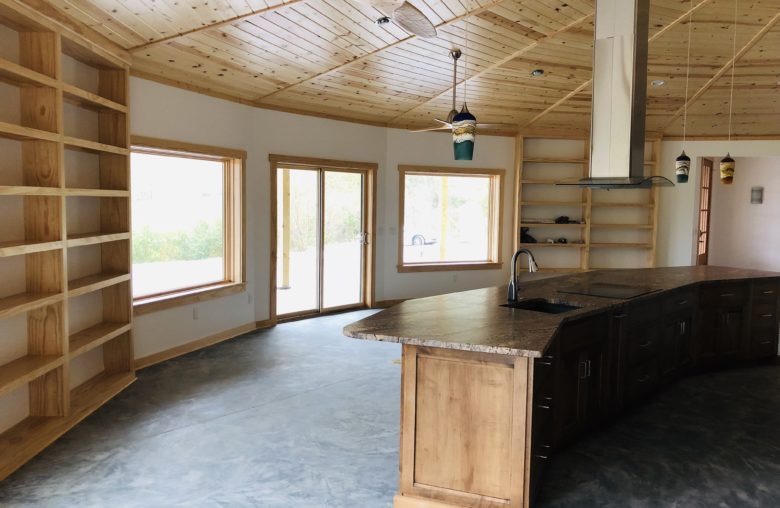As Deltec’s green building manager, I get lots of questions from our clients about green building, from all kinds of angles. I love answering them! But sometimes, I come across industry news or thoughtful articles that answer these questions far better than I could have. Below I share 5 common questions that clients ask me while they’re planning their Deltec Home, with links to recent industry news, digests, or articles to augment my answers.
Q: Have you heard about the Telsa Powerwall?/ Can I get one for my Deltec?/ How many Powerwalls will my Deltec need?
A: There sure is a lot of excitement about the Telsa Powerwall. I get all variations of questions about it in my inbox weekly. However, since Deltec is not a solar supplier or installer, we can’t hook you up with a Powerwall ourselves. Additionally, there are some basic home energy use concepts that make questions like “how many Powerwalls (or solar panels, for that matter) will my home need?” not so simple a question to answer.
Luckily, I know of another North Carolina company, (and fellow BCorp!) called Southern Energy Management who does install Powerwalls. They recently added a great write-up about the Powerwall to their website, answering not just one but seventeen common Powerwall questions.
Q: Can I have a wood stove in my Deltec?
A: Yes! However, you shouldn’t install just any old wood stove, pellet stove, or fireplace, as there are important air quality and safety considerations for stoves and fireplaces in green homes. This has to do with the physics of air pressure and air movement in homes that are quite air-tight. Additionally, whether a wood stove will ultimately get used very often, or is really better for the environment, are much more complex questions.
As with many hot topics in green building about which there are Many Opinions on the Internet, it’s best to turn to the Musings of an Energy Nerd blog over at Green Building Advisor for a thoughtful overview of the technical, practical, and environmental nuances of wood stoves. Since Deltec Homes are capable of reaching Passive House levels of air-tightness, the section about using wood stoves in Passive Houses is especially appropriate. Our current recommendation is to use only EPA Phase II certified models with a sealed outside air intake that connects directly to the firebox.
Also check out this infographic from the EPA about the health effects of wood smoke.
Q: What is a fresh air exchanger, and does my Deltec need one?
A: Fresh air is highly recommended in new homes, and is actually becoming a matter of energy code in an increasing number of states. Fresh air is certainly required for any green building certification program such as Energy Star or LEED for Homes, and that’s because it’s a really good idea!
The reason that new homes need fresh air systems (when older homes often didn’t) has once again to do with house pressures and air-tightness. Here is a great video from Broan that explains the principles behind fresh air systems for homes.
Q: What’s better, a vented or an un-vented attic? / My spray foam contractor is telling me that I don’t need to vent my attic! Is that right?
A: There are some attic designs in the building code that do not require ventilation, a spray foamed attic is often one of them, and while either a vented or un-vented attic will work, there are some energy benefits from an un-vented attic to consider. To understand all this, it’s critical to get an idea of the physics reasons behind attic ventilation to begin with. This in turn depends on what climate zone you are in. Rather than go into this myself here (though I’m known to write novels about this to my clients over email), I am going to let renowned building scientist Joe Lstiburek answer this in one of his thorough, educational (and occasionally comical) Building Science Digests. In fact, this is probably the single article that I share with clients the most.
Q: Is it OK to use fiberglass batt insulation in my Deltec?
A: Most types of insulation will work in a Deltec, and each has its pros and cons. Fiberglass insulation is still the most common and generally inexpensive type of insulation available. Although some builders like to hate on it, whether or not fiberglass is a good idea is really about how well the fiberglass is installed, and about how well the installer and designer understand building science.
BONUS CONTENT: Electricity fuel sources in your state
While I don’t often get this specific question, I work with people all the time who are conscious of the environmental impacts of the energy use in their homes. Even the most energy efficient of homes is still going to need some electricity–in fact, there’s growing movement in green building behind the idea that total electrification makes sense, as there are highly efficient electric options for many household appliances, and even electric cars are becoming more common. Of course, the environmental impact of electricity depends greatly on how it is produced, which in turn varies depending on where you live.
If you’ve ever wondered where the electricity in your state comes from (and if it’s getting any greener by now) you’re not alone. I just found this summary that uses nice visuals that shows both the current mix of fuel sources for the electricity produced in each state, and how those fuel sources have changed over the past 7 years.
________
Interested in green building? These questions, and many more, are just a small taste of the kinds of things our green building and building science department can discuss with you about your specific project when you choose to build a Deltec Home.
